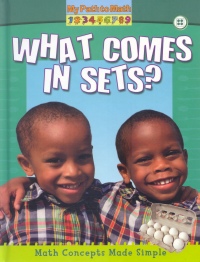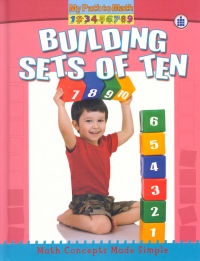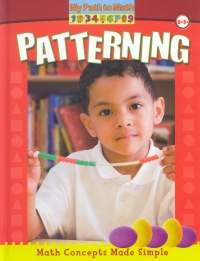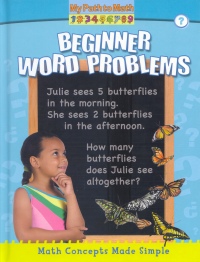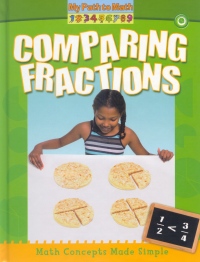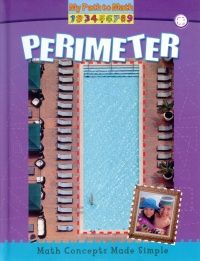| ________________
CM . . . . Volume XIX Number 3 . . . . September 21, 2012
excerpts:
The six books reviewed here are from the series "My Path to Math" by Crabtree Publishing, which, up to now, has grown to a set of 38 books. The series is designed for primary grade students and teachers. Each of the volumes has 24 pages. Each double-page in a volume addresses one particular aspect of the mathematical concept and idea the whole volume deals with. The text is printed in larger font (appropriate for primary school children), and there are many coloured pictures and images used that often provide a pictorial representation of the respective mathematical concepts and ideas. Each volume has an index page at the end as well as a double-page glossary in which the central terms used in the respective volume are explained in one sentence. All the volumes reviewed here are written to help students with developing conceptual understanding of mathematical concepts and ideas. Practising procedural fluency is not part of any of the books. In most cases, the reviewed volumes do a very good job in extracting the central ideas of each concept a volume deals with and provide some meaningful activities for students to engage in to help them with the respective concept. While the basis upon which each volume deals with a particular mathematical concept and idea is sound in terms of what a teacher should consider in her/his teaching of mathematics, the volumes are, in my view, of only limited value as books for students to learn from by reading them on their own. This has to do with what the publisher seems not to acknowledge. The book series has a motto that is printed at the bottom of each cover: "Math Concepts Made Simple". Mathematical concepts and ideas are complex and abstract, and they cannot be made simple. Understanding mathematical concepts and ideas requires engagement with those concepts and ideas in meaningful and various ways. Mathematics education research would strongly suggest that the different aspects of mathematical concepts, like repeating pattern, growing pattern, using a formula to find the perimeter of a shape, and so on, cannot be learned by students reading a double page. It requires engagement with a number of different tasks, generally facilitated by a teacher; and it is as a teacher's resource to engage students in thinking about mathematical ideas that I see the primary value of the book series. Supplemented with other materials and activities, the volumes provide teachers with a number of mental and physical activities and visual representations that teachers can use to engage students with the respective mathematical ideas and concepts in a meaningful way. Two issues stand out with the series from a Canadian school perspective. First, where measurement is involved, like in the Perimeter volume, the Imperial unit system (inches, feet, etc.) is primarily used, and it is the dominant system used and taught in the US, while Canadian curricula teach the metric system. Second, and again with the US market in mind, the books in the series show images of Caucasian, Afro-American, and Hispanic children and adults, but there are no images of students, teachers, or parents that reflect the multi-ethnic backgrounds of Canadians, and in particular, there are not images of Aboriginal students or parents in any of the books. Some of the reviewed books have received lower recommendation ratings than other books in the series because those books include some problems with the way in which the respective concept is introduced to the reader. One of those books is Comparing Fractions. When the term of a fraction is introduced, no reference is made to the fact that the parts into which a whole is divided need to be equal-size parts in order for the concept of a fraction to apply (at least in the examples provided in the book). On one page, the phrase "equal parts" is used, but only in passing, and, more problematically, on page 9 a red pepper, a tomato, and a cob of corn are cut into three, four, and five pieces, respectively to illustrate thirds, fourths, and fives, respectively. However, the parts into which the three vegetables are cut are not equal in size in each of the three cases. Misleading is also the egg carton example on page 12. Here one six-egg carton is filled with two eggs and the other one with three eggs, and the two questions next to them ask: "Which carton has more eggs? Which fraction is bigger?" The first question does actually not involve fractions; it involves whole numbers and can be solved by counting the number of eggs in each carton. To make the carton problem a fraction problem, it is central that the learner can conceptualize the two eggs in the one carton as part of a whole, namely the set of six eggs. The question "Which carton has more eggs?", however, focuses the reader away from the set of six as a the whole. Conceptually, the egg carton example is quite different from the previous fraction examples presented in the book (maybe with the example of the bunch of radishes two pages prior); the egg carton example is an example where the whole is a set of objects rather than one object that is divided into equal parts, as is the case in (almost) all the other examples in the book. There is a big conceptual difference, and the latter is far more difficult for students to comprehend than the former. It probably would have been better if "fractions of sets of object" had been dealt with as a separate subtopic. As well, the book Perimeter includes some conceptual challenges and one mistake. The latter is on page 7. There, the author claims that a rug will fit into a room because the perimeter of the room is larger than the perimeter of the rug. This cannot be the reason alone because, if a rug has dimension larger than any of the two dimensions of the room, the rug will not fit into the room, regardless whether the perimeter of the rug is shorter than the perimeter of the room. For instance, a rug with the dimensions 12x2 will not fit into a room 10x10, although the perimeter of the former is smaller than the perimeter of the latter. Conceptually challenging in the book is the dealing with area grids used to measure perimeter, as is done on pages 8-9 and 20-21. To help students distinguish conceptually between area and perimeter and how each is measured, it is important to emphasize that linear units are used to measure perimeter – the book does so, but the use of a grid on top of a pool to measure the perimeter of the pool is misleading because it is suggested that "if they count the squares on the grid as they walk around the pool they will know the pool's perimeter" (p. 8). It should have been emphasized that it is the length of the one side of each square that is used to measure the perimeter of the pool rather than the squares themselves. The book's approach in using area grids is even more problematic on p. 21, where the author writes, "A floor plan shows the dimensions of each room of the house. Each square of the grid paper is equal to one foot." That is conceptually misleading since a square is a two dimensional shape and does not represent a linear measurement unit like one foot! Recommended with reservations. Thomas Falkenberg is a teacher educator in the Faculty of Education at the University of Manitoba in Winnipeg, MB.
To comment
on this title or this review, send mail to cm@umanitoba.ca.
Copyright © the Manitoba Library Association. Reproduction for personal
use is permitted only if this copyright notice is maintained. Any
other reproduction is prohibited without permission.
NEXT REVIEW |
TABLE OF CONTENTS FOR THIS ISSUE
- September 21, 2012.
AUTHORS |
TITLES |
MEDIA REVIEWS |
PROFILES |
BACK ISSUES |
SEARCH |
CMARCHIVE |
HOME |
